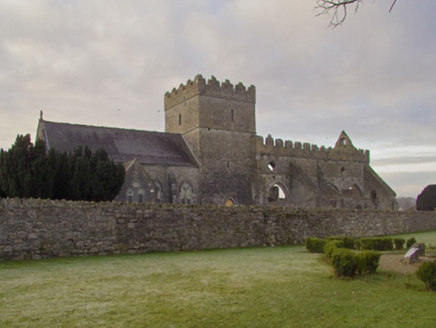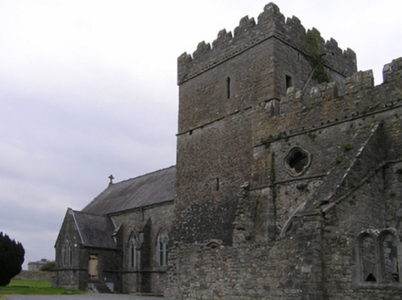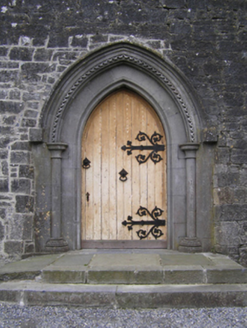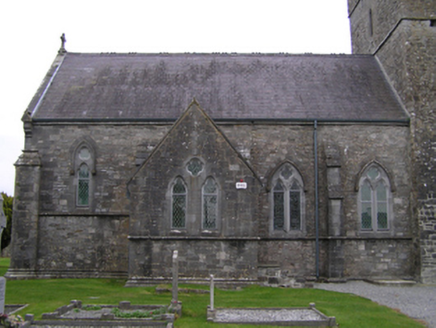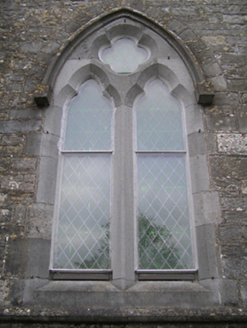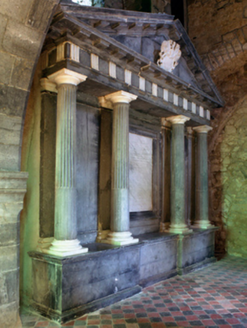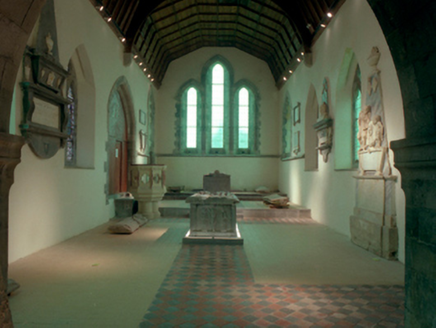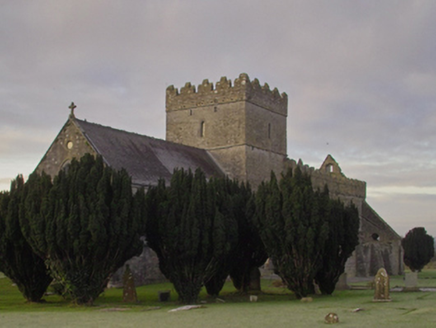Survey Data
Reg No
12310009
Rating
National
Categories of Special Interest
Archaeological, Architectural, Artistic, Historical, Scientific, Social, Technical
Original Use
Church/chapel
In Use As
Museum/gallery
Date
1870 - 1875
Coordinates
263378, 153441
Date Recorded
17/05/2004
Date Updated
--/--/--
Description
Attached four-bay double-height Church of Ireland church, built 1871, on a rectangular plan comprising three-bay double-height nave opening into single-bay full-height chancel (east). Restored, 1994-5. Pitched slate roof with chevron- or saw tooth-crested roll moulded clay ridge tiles, cut-limestone coping to gable on drag edged tooled cut-limestone gabled "Cavetto" kneelers with Cross finial to apex, and cast-iron rainwater goods on cut-limestone eaves retaining cast-iron square profile downpipes. Part ivy-covered tuck pointed snecked limestone walls on lichen-covered cut-limestone "slated" plinth with drag edged tooled cut-limestone buttresses having cut-limestone "slated" coping including benchmark-inscribed piers to corners having cut-limestone "slated" coping. Pointed-arch window openings on cut-limestone stringcourse with dragged cut-limestone mullions, and dragged cut-limestone block-and-start surrounds having chamfered reveals with hood mouldings on monolithic label stops framing storm glazing over fixed-pane fittings having lattice glazing bars. Trefoil-headed lancet window openings (east) on lichen-covered cut-limestone chamfered stringcourse, dragged cut-limestone block-and-start surrounds having chamfered reveals with hood mouldings on monolithic label stops framing storm glazing over fixed-pane fittings having lattice glazing bars. Lancet "Trinity Window" to chancel (east) on lichen-covered cut-limestone chamfered stringcourse, dragged cut-limestone block-and-start surrounds having engaged colonette-detailed reveals with hood mouldings on monolithic label stops framing storm glazing over fixed-pane fittings having lattice glazing bars. Interior including vestibule (west) retaining tessellated "quarry tile" floor; pointed-arch opening into nave; full-height interior open into roof with tessellated "quarry tile" central aisle, Classical-style wall monuments (----), pair of stained glass memorial windows (1918; 1920), encaustic tiled stepped dais to chancel (east), and exposed timber roof construction on cut-granite beaded corbels with timber boarded polygonal vaulted ceiling in carved timber frame on timber cornice. Set in landscaped grounds.
Appraisal
A church erected to designs signed (1871) by Thomas Henry Wyatt (1807-80) of London (RCB) representing an important component of the ecclesiastical heritage of County Kilkenny with the architectural value of the composition, one abutting 'a very ancient cruciform structure [which] has some very interesting details in the early English style' [SMR KK 020-060006-], confirmed by such attributes as the compact rectilinear plan form, aligned along a liturgically-correct axis; and the slender profiled of the openings underpinning a "medieval" Hard Gothic theme with the chancel defined by an elegant "Trinity Window". Having been well maintained, the elementary form and massing survive intact together with substantial quantities of the original fabric, both to the exterior and to the deconsecrated interior restored (1994-5) by the Office of Public Works where a temple-like monument commemorating James Agar (1672-1733); Classical wall monuments by Edward Smyth (1749-1812) of Dublin and Alexander Ballantine (----) of Dublin; a window (1918) by Michael Healy (1873-1941) of An Túr Gloine commemorating 'Lieutenant Aubrey Cecil White [1896-1916] who fell in action while leading his men in the Battle of the Somme'; and a window (1920) by Hubert McGoldrick (1897-1967) of An Túr Gloine commemorating 'H.J.C. [Hector James Charles] Toler-Aylward [1839-1918] Shankill Castle', all highlight the considerable artistic potential of the composition: meanwhile, an exposed timber roof construction pinpoints the engineering or technical dexterity of a church making a pleasing visual statement in a rural village street scene.
